 Gilman Studio On-Line Lessons
Gilman Studio On-Line Lessons
Yang Style Long Form
Tai Chi Chuan
This Lesson Contains:
Four Important Points and Movement # 9 – Stork Spreads Its Wings
Four Important Points:
The most important points that I can give to the beginning student are these:
¨ 1. Know Yourself
¨ 2. Do Your Best
¨ 3. Do Not Overdo
¨ 4. Make a Little Progress Everyday
Let me explain each of these. Please study them carefully as it could make a great deal of difference to your success and enjoyment in the practice of Tai Chi Chuan.
- Know Yourself — Without this there can be no real progress. Tai Chi is a physical, mental, and spiritual exercise and without taking time to look within, a student can never be aware of what is going on. Tai Chi is a martial art and as such it is of utmost importance to know your opponent and this is impossible if you don’t know yourself. Hopefully most people come to Tai Chi to learn more about themselves, how they work and how they perceive, and this ability to know yourself can be increased. But the desire has to be there. So take the time to look closely at yourself and enjoy your growth and development. This is the foundation for all that is to follow.
- Do Your Best — Life is not worth living if you don’t do your best. You won’t feel good about yourself or others if you don’t try always to do your best. And it is important not to compare yourself with others. My best may not be as good as someone else’s yet I will feel satisfied if I know I did my best. In order to do my best I must know myself first so I can know what my best is.
- Do Not Overdo — If you know yourself it is difficult to overdo. Overdoing usually comes from trying to do as much as others without looking at yourself. It is so important in Tai Chi to feel what you are doing and also to take responsibility for yourself in classes and practice. Do not rely on others to fully direct your actions. Trust yourself and always start out slowly and softly and then work up speed and intensity while keeping close attention on how you feel.
- Make a Little Progress Everyday — Tai Chi is designed to be practiced everyday. In the beginning, the student only needs to practice 10 minutes a day to progress if the practice is done with full awareness. An individual can hopefully work up to 20 to 30 minutes a day for the rest of his or her life. Progress should be slow and steady with the emphasis changing from the external physical to the internal mental to the unified spiritual. This is a lifelong journey and one that can be a great tool for keeping us healthy, happy and on the path to self- realization.
Movement # 9 – Stork Spreads Its Wings
This application illustrates an important concept in the self-defense art of Tai Chi Chuan – that of stepping to the side and, if possible, behind the opponent. As my partner attacks with her left hand, I step behind her left side and at the same time neutralize her attack with my left hand. As my body swings around, my right arm returns the energy back to her in the form of a chop to the neck. I can also kick her shin or trip her with my empty left foot. The energy for this movement is mostly Lu Jin or roll back.
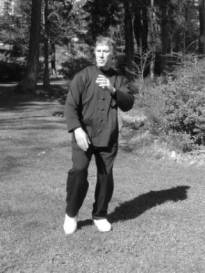
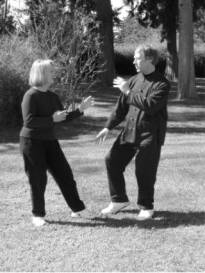 Following Raise Hands, I withdraw my right foot into Ding Bow on Toe and pull my right hand down in front of my crotch. I turn my body slightly to face the right shoulder forward. I am now in center position.
Following Raise Hands, I withdraw my right foot into Ding Bow on Toe and pull my right hand down in front of my crotch. I turn my body slightly to face the right shoulder forward. I am now in center position.
As I said earlier, center position is used often as a transition between movements. I am ready for whatever Stephie has up her sleeve.
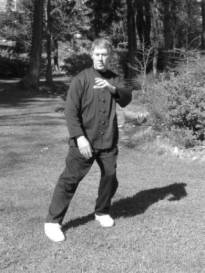
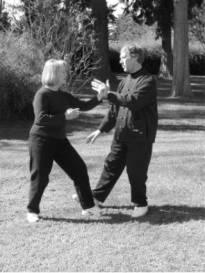 Stephie decides to strike forward with her left fist. I neutralize her fist with the back of my left wrist by joining with her in a soft, sticky fashion. At the same time I step behind her with my right foot.
Stephie decides to strike forward with her left fist. I neutralize her fist with the back of my left wrist by joining with her in a soft, sticky fashion. At the same time I step behind her with my right foot.
In the form, my right foot is lifted and replaced in the same place; only the angle is changed to half way between north and west. Do not shift any weight onto the foot at this point. The hands don’t make much of a change. The right hand reaches forward just a little bit.
Focus your attention on the back of your left wrist to join and on the right foot for proper stepping.
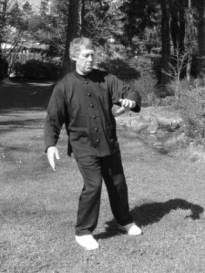 This is the transition phase where I am shifting my weight onto the right foot and starting to turn my body to the left. I would be leading my partner to the left by pulling with my left hand to the left. The right arm is starting to swing up, being propelled by the turning of the waist. Do not change the level of the body when stepping or when moving the weight onto the right foot. Also, notice that as the weight is shifted onto the right foot the left foot pivots on the toe to the left.
This is the transition phase where I am shifting my weight onto the right foot and starting to turn my body to the left. I would be leading my partner to the left by pulling with my left hand to the left. The right arm is starting to swing up, being propelled by the turning of the waist. Do not change the level of the body when stepping or when moving the weight onto the right foot. Also, notice that as the weight is shifted onto the right foot the left foot pivots on the toe to the left.
Focus your attention on the left hand for leading partner to the left.
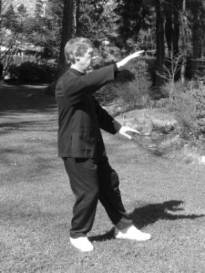
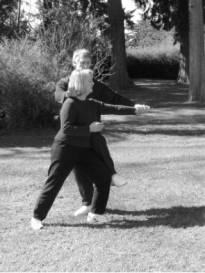 The body has continued turning to the left and ends up facing west. The right foot is doing Ding Bow on Toe. You will have to lift the left foot off the ground and replace it slightly to the front to arrive at the correct foot relationship so the left toe is in line with the left shoulder and in front of the body. The lifting of the foot also lets you know that there is no weight on that foot so you can use it to kick.
The body has continued turning to the left and ends up facing west. The right foot is doing Ding Bow on Toe. You will have to lift the left foot off the ground and replace it slightly to the front to arrive at the correct foot relationship so the left toe is in line with the left shoulder and in front of the body. The lifting of the foot also lets you know that there is no weight on that foot so you can use it to kick.
The left hand has ended up slightly to the left and in front of the left thigh with the palm facing downward. The right arm ends up on the right side of your body with the left edge of the hand facing inward at about your neck level. Keep the shoulders and elbows relaxed.
Focus your energy mostly onto the inside edge of the right palm and wrist to strike and on the left palm to stay joined.
